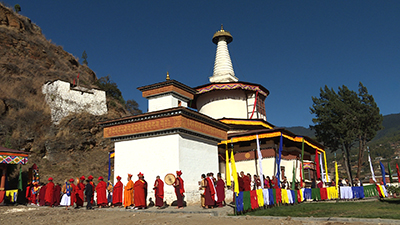 Dumgtseg Lhakhang, located a couple of minutes drive from Paro town towards Dopshar-ri is one of the oldest temples and a popular tourist destination. Built about 600 years back, it’s now restored to its former glory after the renovation.
Dumgtseg Lhakhang, located a couple of minutes drive from Paro town towards Dopshar-ri is one of the oldest temples and a popular tourist destination. Built about 600 years back, it’s now restored to its former glory after the renovation.
The Lhakhang was renovated under the Dumgtseg Lhakhang Restoration Project of Her Majesty the Royal Grandmother Ashi Kesang Choeden Wangchuck since 2017. Her Majesty the Royal Grandmother graced the consecration ceremony of the renovated Lhakhang yesterday.
The consecration ceremony was presided over by the Letshog Lopen of the Zhung Dratshang.
The locals, Paro Rabdey and Dzongkhag offered Buelwa and Ku-Sung-Thuk Mendrel to Her Majesty the Royal Grandmother.
The Lhakhang which is in the form of a Chorten is the only one of its kind in the country. The restoration project handed over the Lhakhang to the fifteen households who own it at Jangsa village in the Paro valley.
“We are very happy to see the Lhakhang renovated. Before the renovation, the area was so congested. Now it’s very wide and comfortable while coming for circumambulation,” said Gaki, from Jangsa under Dopshar-ri Gewog in Paro.
“We haven’t touched much on the architecture inside because it is very sacred. Some of the murals are repainted partially. The main problem was with water in summer because of rain and drain water which is now not an issue anymore,” said Nidup, the Caretaker of the Dumgtseg Lhakhang.
Because the Lhakhang is surrounded by paddy fields on all sides, water seepage has damaged the murals of the walls and wood architecture inside.
So the Royal Grandmother requested a team of Japanese and Bhutanese conservationists to commence the renovation of the Lhakhang in 2017.
 The renovation works were carried out in such a way that the Lhakhang’s original architecture is kept intact. The major renovation works include the restoration of the wall murals to its original form and renovation of the woodworks inside the Lhakhang and the construction of boundary walls on an additional 80 decimal land acquired from three households in the community. During the ceremony, Her Majesty also handed over land certificate (Lagthram) to the landowners from whom the lands were acquired.
The renovation works were carried out in such a way that the Lhakhang’s original architecture is kept intact. The major renovation works include the restoration of the wall murals to its original form and renovation of the woodworks inside the Lhakhang and the construction of boundary walls on an additional 80 decimal land acquired from three households in the community. During the ceremony, Her Majesty also handed over land certificate (Lagthram) to the landowners from whom the lands were acquired.
“We acquired the paddy fields surrounding the Lhakhang and gave locals land substitutes. Then we constructed the boundary walls to prevent water seepage. And while renovating we had experts from Japan where we kept the old architecture intact as per the Royal Grandmother’s wish. While renovating we dug, built and strengthened the base and made sure there is no water seepage. And restored the base to its former form,” said Dasho Rinzin Gyaltshen, the Chairman of Dumgtseg Lhakhang Restoration Project.
“The lower ends of the murals were damaged by water seepage. And the smoke from the butter lamps has dirtied the murals. And also water leaking from the rooftop have damaged the woodworks and murals around the ceilings. We partially repainted the murals which were damaged and left the major part of the murals as it is in the interest of conserving the original form,” added Sonam Tshering, from the Dumgtseg Lhakhang Restoration Project.
The major restoration is being carried out after about 176 years, since the restoration in 1841 by the 25th Je Khenpo Sherab Gyeltshen, according to the village elderly.
In 1841, Je Khenpo Sherab Gyaltshen as a part of restoration extended the Chorten to a 12 sided temple with sidewalk to circumambulate. It is said that the Je Khenpo has asked people of 12 villages to bring pillars as a contribution and upon which the Lhakhang was constructed. Today the Lhakhang has 12 wooden pillars painted in red with names of the villages who donated, carved on them.
Conservationists believed that these pillars are part of the original structure and hence did not touch them while renovating except for one, which was partially renovated.
Despite not having recorded history, many elderly in the village share that Thangtong Gyalpo built the Lhakhang to prevent a serpent who was taking shelter around the premise from harming the locals and to wipe out leprosy. The historic structure houses some of the exquisite and sacred thangkas in the country.
“Paro valley was divided into two by this hill behind the Chorten. And then on the joint, the end of the hill it was said that one deadly serpent was taking shelter and because of the serpentine’s force the people in the area were affected with leprosy and deadly diseases. To subdue all these the Chorten was built on the head of the serpent. This is what we have been hearing,” said Dasho Rinzin Gyaltshen.
Her Majesty the Royal Grandmother and her mother felt a great affinity towards the Lhakhang and commissioned the restoration works back in the 1980s as well and also built a Dremed Namgyal Chorten.
Dumgtseg Lhakhang derives the name from its architectural structure. The three temples inside are built around the central axle pole which runs right through the middle from the ground floor to the crest of the temple.
Phub Gyem






